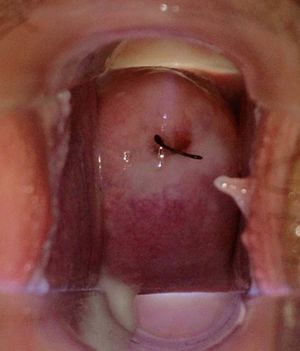
Vaginal discharge

Vaginal discharge is a mixture of liquid, cells, and bacteria that lubricates and protects the vagina. This mixture is constantly produced by the cells of the vagina and cervix and it exits the body through the vaginal opening. The composition, amount, and quality of discharge varies between individuals as well as through the various stages of sexual and reproductive development. Normal vaginal discharge may have a thinner, watery consistency or a thick, sticky consistency, and may be clear or white in color. Normal vaginal discharge may be large in volume but typically does not have a strong odor, nor is it typically associated with itching or pain. While most discharge represents normal functioning of the body, some changes in discharge can reflect infection or other pathological processes. Infections that may cause changes in vaginal discharge include vaginal yeast infections, bacterial vaginosis, and sexually transmitted infections. The characteristics of abnormal vaginal discharge vary depending on the cause, but common features include a change in color, a foul odor, and associated symptoms such as itching, burning, pelvic pain, or pain during sexual intercourse. Vaginal discharge is a mixture of liquid, cells, and bacteria that lubricates and protects the vagina. This mixture is constantly produced by the cells of the vagina and cervix and it exits the body through the vaginal opening. The composition, amount, and quality of discharge varies between individuals as well as through the various stages of sexual and reproductive development. Normal vaginal discharge may have a thinner, watery consistency or a thick, sticky consistency, and may be clear or white in color. Normal vaginal discharge may be large in volume but typically does not have a strong odor, nor is it typically associated with itching or pain. While most discharge represents normal functioning of the body, some changes in discharge can reflect infection or other pathological processes. Infections that may cause changes in vaginal discharge include vaginal yeast infections, bacterial vaginosis, and sexually transmitted infections. The characteristics of abnormal vaginal discharge vary depending on the cause, but common features include a change in color, a foul odor, and associated symptoms such as itching, burning, pelvic pain, or pain during sexual intercourse. Normal vaginal discharge is composed of cervical mucus, vaginal fluid, shedding vaginal and cervical cells, and bacteria. The majority of the liquid in vaginal discharge is mucus produced by glands of the cervix. The rest is made up of transudate from the vaginal walls and secretions from glands (Skene's and Bartholin's). The solid components are exfoliated epithelial cells from the vaginal wall and cervix as well as some of the bacteria that inhabit the vagina. These bacteria that live in the vagina do not typically cause disease. In fact, they can protect the individual from other infectious and invasive bacteria by producing substances such as lactic acid and hydrogen peroxide that inhibit growth of other bacteria. The normal composition of bacteria in the vagina (vaginal flora) can vary, but is most commonly dominated by lactobacilli. On average, there are approximately 108 to 109 bacteria per milliliter of vaginal discharge. Normal vaginal discharge is clear, white, or off-white. The consistency can range from milky to clumpy, and odor typically mild to non-existent. The majority of the discharge pools in the deepest portion of the vagina (the posterior fornix) and exits the body over the course of a day with the force of gravity. A typical reproductive-age woman produces 1.5 grams (half to one teaspoon) of vaginal discharge every day. During sexual arousal and sexual intercourse, the amount of fluid in the vagina increases due to engorgement of blood vessels surrounding the vagina. This engorgement of blood vessels increases the volume of transudate from the vaginal walls. Transudate has a neutral pH, so increases in its production can temporarily shift vaginal pH to be more neutral. Semen has a basic pH and can neutralize the acidity of the vagina for up to 8 hrs. The composition and amount of vaginal discharge changes as an individual goes through the various stages of sexual and reproductive development. In neonates, vaginal discharge sometimes occurs in the first few days after birth. This is due to exposure to estrogen while in utero. Neonatal vaginal discharge may be white or clear with a mucous texture, or it may be bloody from normal transient shedding of the endometrium. The vagina of girls before puberty is thinner and has a different bacterial flora. Vaginal discharge in pre-pubertal girls is minimal with a neutral to alkaline pH ranging from 6 to 8. The composition of the bacterial population in pre-pubertal girls is dominated by staphylococcus species, in addition to a range of anaerobes, enterococci, E. coli, and lactobacillus. During puberty, the hormone estrogen begins to be produced by the ovaries. Even before the beginning of menses (up to 12 months before menarche, typically at the same time as the development of breast buds,) vaginal discharge increases in amount and changes in composition. Estrogen matures vaginal tissues and causes increased production of glycogen by epithelial cells of the vagina. These higher levels of glycogen in the vaginal canal support the growth of lactobacilli over other bacterial species. When lactobacilli use glycogen as a food source, they convert it to lactic acid. Therefore, the predominance of lactobacilli in the vaginal canal creates a more acidic environment. In fact, the pH of the vagina and vaginal discharge after puberty ranges between 3.5 and 4.7.
